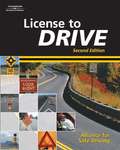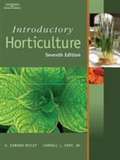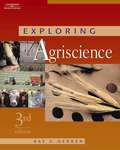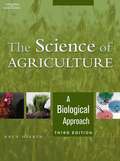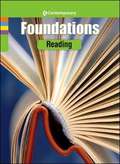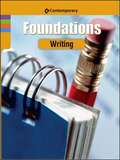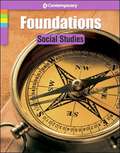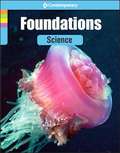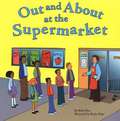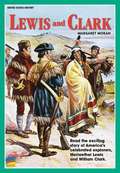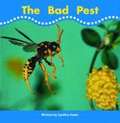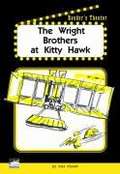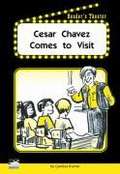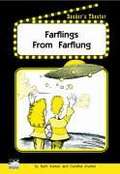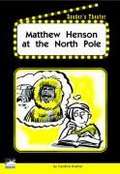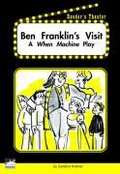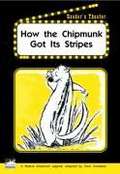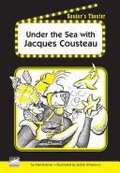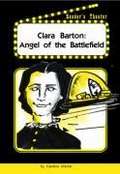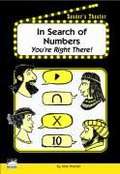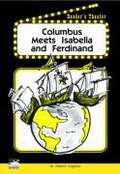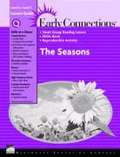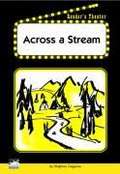- Table View
- List View
More NIMAC books are available at www.nimac.us. If you find your title in the NIMAC and not in Bookshare then please contact us to request it.
License to Drive
by Alliance for Safe DrivingLicense to Drive offers you a totally integrated solution to driver education. Using a realistic approach, it covers all major driver education issues, with an emphasis on safety and defensive driving that will appeal to all new drivers. The focus is on practical solutions to everyday situations, with thoughtful coverage of such subjects as driving under the influence, sharing the road, challenging driving conditions and "road rage. " The Annotated Teacher's Edition includes an Activity Disk that instructors
Exploring Agriscience, 3rd Edition
by Ray V. HerrenExploring Agriscience, third edition, is a middle school text for students in Agricultural Education Programs who are enrolled in their first agriculture or agriscience class. Contents center on an exploration of agricultural industry as well as an explanation of how science concepts are used in agriculture. Topics covered include The history of agriculture; Soils, Plant structures; Entomology; Floriculture; Nursery and Landscaping; Fruit and Nuts; Row crops; Forestry; The Environment; Organic agriculture; Animal Science (including Dairy and Poultry); Aquaculture; Companion Animals; Ethics; Biotechnology; Careers; Agricultural Mechanics; Food Science; and Agricultural Education Programs. The text is illustrated with full color images that help clarify text material. Each chapter contains an insert that provides a description of an FFA Career Development Event (CDE) that relate directly to the chapter topic. Each chapter contains student learning activities that help students relate the text concepts to real life. In addition, each chapter ends with True/False, Multiple Choice and discussion questions to help evaluate student learning. An extensive teaching/learning package for the text is available. This package includes an instructor's guide, a lab model, and a classmaster CD-ROM that contains transparency masters, lesson plans, and a computerized test bank.
The Science of Agriculture: A Biological Approach
by Ray V. HerrenThe Science of Agriculture: A Biological Approach, third edition helps students bridge the gap between biological concepts and their applications. The text concentrates on the scientific principles, or the "why" behind the industry. Topics such as plant and animal systems, soils, cell functions, genetics, genetic engineering, plant and animal reproduction, entomology, the uses of biotechnology, and careers are covered throughout the text. The text also includes a thorough examination of the controversy and concerns over the use of genetic engineering, genetically modified organisms, cloning, and their perceived and potential dangers to humans and the environment. Each chapter begins with clearly-stated learning objectives, followed by key terminology. Chapters close with student learning activities that extend learning beyond the text material. End-of-chapter test questions in True/False; Short Answer/Discussion; and Multiple Choice formats help to evaluate students' grasp of the concepts presented in the text.
myWorld Interactive 5: Social Studies, South Carolina
by Linda B. Bennett James B. Kracht Paul ApodacaNIMAC-sourced textbook
Contemporary Foundations: Reading
by McGraw-HillContemporary's Foundations series helps students improve their basic skills. Each book provides skill instruction, offers interesting passages to study, and furnishes opportunities for practice. Foundations provides meaningful contexts for learning, using language which is easy to understand. About Foundations: Reading, Revised Edition: Foundations: Reading will help students improve their reading ability, as well as their writing and thinking skills. Foundations: Reading is divided into four units: Practical Reading: ''survival'' reading that you do everyday. Practical reading includes instructions, advertisements, and explanations. Reading Nonfiction: writing based on facts. Nonfiction includes newspaper and magazine articles, books about real people and real events, and encyclopedia articles. Reading Poetry: verse that captures a person's feelings. Learning to recognize form, rhythm, rhyme, and images will help you read and appreciate poetry. Reading Short Fiction: stories created from an author's imagination. Characters, setting, plot, and theme are important elements in every story. These special features in Foundations: Reading will help students practice language skills: Writing Workshops: detailed instructions that will guide the student through the four-step writing process: prewriting, drafting, revising, and editing Language Tips: explanations, pronunciations, study hints, and background information that will help the student understand what he or she is reading Test Skills: a reminder that this skill is often tested on standardized tests Posttest: a test, evaluation chart, and answer key, to gauge the mastery of each skill. Revised Edition Features: New language tips, Updated content, including revised passages, updated graphs and images, More exercises. About the Series: In Foundations: Reading, students will read practical information, nonfiction, poetry, and short stories. They will learn to find the main point and the details; identify fact, opinion, and bias; make inferences; read photographs and cartoons; and understand rhythm, rhyme, plot, and theme. Writing Workshops, Language Tips, and prereading questions are designed to improve reading, writing, and thinking skills. In Foundations: Writing, students will practice the four steps to writing an essay: prewriting, drafting, revising, and editing. They will read and write five kinds of essays: descriptive essays, personal narratives, how-to essays, essays of example, and comparison-and-contrast essays. A language-skills workbook provides grammar, punctuation, and sentence structure practice. In Your Journal, With a Partner, and Language Tips will help students become better writers, and better readers and thinkers as well. In Foundations: Science, students will learn about the human body, plant biology, physics, chemistry, and Earth science. They will practice putting events in order; reading diagrams, charts, and graphs; using the scientific method; and making comparisons and contrasts. Try It yourself! activities will guide students through simple experiments so they will have a better understanding of what they have been reading about. Writing Workshops and Language Tips will help students use their reading and writing skills to think about science topics. In Foundations: Social Studies, students will learn about world history, U.S. history, civics and government, geography, and economics. They will summarize, make predictions, infer the main idea of cartoons, find information on maps, and read various kinds of graphs. Background Information, Language Tips, and Writing Workshops will let students use what they already know as they read and write about social studies topics. The revised edition includes a new World History chapter. In Foundations: Math, students will practice using whole numbers, money, decimals, fractions, ratios, and percents. Exercises will help students review the addition, subtraction, multiplication, and division facts; round numbers; estimate answers; and solve word problems. Math Notes, On their Calculator, and Language ...
Contemporary Foundations: Writing
by McGraw Hill Wright GroupContemporary'sFoundationsseries helps students improve their basic skills. Each book provides skill instruction, offers interesting passages to study, and furnishes opportunities for practice.Foundationsprovides meaningful contexts for learning, using language which is easy to understand. Foundations: Writingwill help students improve their writing skills, as well as their reading and thinking skills. Part I: Writing helps students practice the four stages of the writing process: Prewriting: planning and organizing Drafting: writing by following a plan Revising: evaluating and rewriting Editing: correcting grammar, mechanics, and usage Students will learn about five types of essays and practice writing each type: Descriptive Essay Personal Narrative How-To Essay Essay of Example Comparison-and-Contrast Essay Part II: Grammar focuses on language skills that writers need to understand. Grammar: nouns, pronouns, verbs, adjectives, and adverbs Punctuation: periods, question marks, exclamation marks, commas, and semicolons Sentence Structure: incomplete sentences, run-on sentences, and comma splices The following special features will help students practice their writing skills. In Your Journal: ideas to think about and write about on your own Language Tip: explanations, pronunciations, study hints, and background information that will help students understand what they read Test Skills: a reminder that this skill is often tested on standardized tests With a Partner: reading, writing, and thinking activities to do with a classmate, family member, or friend Posttest: a test, evaluation chart, and answer key to guage skill mastery Revised Edition Features: New language tips Updated content, including revised passages, updated graphs and images More exercises About the Series: In Foundations: Reading, students will read practical information, nonfiction, poetry, and short stories. They will learn to find the main point and the details; identify fact, opinion, and bias; make inferences; read photographs and cartoons; and understand rhythm, rhyme, plot, and theme. Writing Workshops, Language Tips, and prereading questions are designed to improve reading, writing, and thinking skills. In Foundations: Writing, students will practice the four steps to writing an essay: prewriting, drafting, revising, and editing. They will read and write five kinds of essays: descriptive essays, personal narratives, how-to essays, essays of example, and comparison-and-contrast essays. A language-skills workbook provides grammar, punctuation, and sentence structure practice. In Your Journal, With a Partner, and Language Tipswill help students become better writers, and better readers and thinkers as well. In Foundations: Science, students will learn about the human body, plant biology, physics, chemistry, and Earth science. They will practice putting events in order; reading diagrams, charts, and graphs; using the scientific method; and making comparisons and contrasts. Try It yourself!activities will guide students through simple experiments so they will have a better understanding of what they have been reading about. Writing Workshops and Language Tips will help students use their reading and writing skills to think about science topics. In Foundations: Social Studies, students will learn about world history, U.S. history, civics and government, geography, and economics. They will summarize, make predictions, infer the main idea of cartoons, find information on maps, and read various kinds of graphs. Background Information, Language Tips, and Writing Workshops will let students use what they already know as they read and write about social studies topics. The revised edition includes a new World History chapter. In Foundations: Math, students will practice using whole numbers, money, decimals, fractions, ratios, and percents. Exercises will help students review the addition, subtraction, multiplication, and division facts; round numbers; estimate answers; and solve word problems. Math Notes, On their Calculator, and Language Ti...
Contemporary Foundations: Social Studies
by Wright Group/McGraw-HillContemporary'sFoundationsseries helps students improve their basic skills. Each book provides skill instruction, offers interesting passages to study, and furnishes opportunities for practice.Foundationsprovides meaningful contexts for learning, using language which is easy to understand. AboutFoundations: Social Studies, Revised Edition : In Foundations: Social Studies, students will learn about world history, U.S. history, civics and government, geography, and economics. They will summarize, make predictions, infer the main idea of cartoons, find information on maps, and read various kinds of graphs. Background Information,Language Tips, andWriting Workshops will let students use what they already know as they read and write about social studies topics. The revised edition includes a new World History chapter. About the Series: In Foundations: Reading, students will read practical information, nonfiction, poetry, and short stories. They will learn to find the main point and the details; identify fact, opinion, and bias; make inferences; read photographs and cartoons; and understand rhythm, rhyme, plot, and theme. Writing Workshops, Language Tips, and prereading questions are designed to improve reading, writing, and thinking skills. In Foundations: Writing, students will practice the four steps to writing an essay: prewriting, drafting, revising, and editing. They will read and write five kinds of essays: descriptive essays, personal narratives, how-to essays, essays of example, and comparison-and-contrast essays. A language-skills workbook provides grammar, punctuation, and sentence structure practice. In Your Journal, With a Partner, and Language Tipswill help students become better writers, and better readers and thinkers as well. In Foundations: Science, students will learn about the human body, plant biology, physics, chemistry, and Earth science. They will practice putting events in order; reading diagrams, charts, and graphs; using the scientific method; and making comparisons and contrasts. Try It yourself!activities will guide students through simple experiments so they will have a better understanding of what they have been reading about. Writing Workshops and Language Tips will help students use their reading and writing skills to think about science topics. In Foundations: Social Studies, students will learn about world history, U.S. history, civics and government, geography, and economics. They will summarize, make predictions, infer the main idea of cartoons, find information on maps, and read various kinds of graphs. Background Information, Language Tips, and Writing Workshops will let students use what they already know as they read and write about social studies topics. The revised edition includes a new World History chapter. In Foundations: Math, students will practice using whole numbers, money, decimals, fractions, ratios, and percents. Exercises will help students review the addition, subtraction, multiplication, and division facts; round numbers; estimate answers; and solve word problems. Math Notes, On their Calculator, and Language Tips will help students improve math skills. The revised edition of Math is a major revision. The language has been updated to make the material even easier to follow than before. Foundations series at a glance
Contemporary Foundations: Science
by Wright Group/McGraw-HillContemporary's Foundations series helps students improve their basic skills. Each book provides skill instruction, offers interesting passages to study, and furnishes opportunities for practice.Foundations provides meaningful contexts for learning, using language which is easy to understand. About Foundations: Science, Revised Edition : In Foundations: Science, students will learn about the human body, plant biology, physics, chemistry, and Earth science. They will practice putting events in order; reading diagrams, charts, and graphs; using the scientific method; and making comparisons and contrasts. Try It yourself! activities will guide students through simple experiments so they will have a better understanding of what they have been reading about.Writing Workshops and Language Tips will help students use their reading and writing skills to think about science topics. About the Series: In Foundations: Reading, students will read practical information, nonfiction, poetry, and short stories. They will learn to find the main point and the details; identify fact, opinion, and bias; make inferences; read photographs and cartoons; and understand rhythm, rhyme, plot, and theme. Writing Workshops, Language Tips, and prereading questions are designed to improve reading, writing, and thinking skills. In Foundations: Writing, students will practice the four steps to writing an essay: prewriting, drafting, revising, and editing. They will read and write five kinds of essays: descriptive essays, personal narratives, how-to essays, essays of example, and comparison-and-contrast essays. A language-skills workbook provides grammar, punctuation, and sentence structure practice. In Your Journal, With a Partner, and Language Tips will help students become better writers, and better readers and thinkers as well. In Foundations: Science, students will learn about the human body, plant biology, physics, chemistry, and Earth science. They will practice putting events in order; reading diagrams, charts, and graphs; using the scientific method; and making comparisons and contrasts. Try It yourself! activities will guide students through simple experiments so they will have a better understanding of what they have been reading about. Writing Workshops and Language Tips will help students use their reading and writing skills to think about science topics. In Foundations: Social Studies, students will learn about world history, U.S. history, civics and government, geography, and economics. They will summarize, make predictions, infer the main idea of cartoons, find information on maps, and read various kinds of graphs. Background Information, Language Tips, and Writing Workshops will let students use what they already know as they read and write about social studies topics. The revised edition includes a new World History chapter. In Foundations: Math, students will practice using whole numbers, money, decimals, fractions, ratios, and percents. Exercises will help students review the addition, subtraction, multiplication, and division facts; round numbers; estimate answers; and solve word problems. Math Notes, On their Calculator, and Language Tips will help students improve math skills. The revised edition of Math is a major revision. The language has been updated to make the material even easier to follow than before.
Field Trips: Out and About at the Supermarket
by Kitty Shea Peggy Henrikson Becky ShipeCome along on fun field trips to some important and amazing places! Young readers join the group and take the tour, learning fascinating facts along the way.
Field Trips: Out and About at the Newspaper
by Kitty Shea Jill Kalz Zachary TroverA group of children go on a field trip for a guided tour of a newspaper, where they learn how reporters, photographers, and other staff members work together to publish a newspaper. Includes an activity.
Lewis and Clark
by Margaret Moran Pam HirschfeldFind out about Meriwether Lewis and William Clark by joining them on their journey as they meet many people who help guide them on their search for the Northwest Passage. (Set of 6 with Teacher's Guide and Comprehension Question Card)
The Wright Brothers at Kitty Hawk
by Alan Kramer Pam Hirschfeld Karen LeonPerform this script about two children who travel in a time machine to Kitty Hawk, North Carolina, to meet the Wright brothers.
Cesar Chavez Comes to Visit
by Candice Kramer Pam Hirschfeld Karen LeonPerform this script about Cesar Chavez as he educates students about the plight of migrant workers.
Farflings From Farflung
by Ruth Romer Candice Kramer Pam Hirschfeld Albert HannerPerform this script about aliens who travel to Earth to learn about gravity.
Matthew Henson at the North Pole
by Candice Kramer Pam Hirschfeld Karen LeonPerform this script about Robert Peary's discovery of the North Pole and how his assistant, Matthew Henson, played a major role in the expedition.
Ben Franklin's Visit: A When Machine Play
by Candice Kramer Pam Hirschfeld Karen LeonPerform this script about key figures from American history as they travel to the future to learn about modern technology.
How the Chipmunk Got Its Stripes
by Staci Swedeen Pam Hirschfeld Jackie UrbanovicPerform this script about a Native American legend about how a chipmunk got its stripes.
Under the Sea with Jacques Cousteau
by Alan Kramer Pam Hirschfeld Jackie UrbanovicSeveral ocean animals including crabs sea turtles and whales discuss their unique characteristics in anticipation of a visit from marine explorer Jacques Cousteau. Each animal hopes to be featured in one of Cousteau's TV documentaries.
Clara Barton: Angel of the Battlefield
by Candice Kramer Pam Hirschfeld Karen LeonPerform this script about a girl and her father who travel to the 19th century to visit Clara Barton.
In Search of Numbers
by Alan Kramer Pam Hirschfeld Jackie UrbanovicPerform this script about a TV reporter who goes back in time to find out about the history of numbers.
The Golden Spike
by Stephen Cosgrove Kitty Higgins Pam Hirschfeld Jackie UrbanovicPerform this script about the linking of the Union Pacific Railroad and the Central Pacific Railroad to form the Transcontinental Railroad.
Across a Stream
by Stephen Cosgrove Pam Hirschfeld Karen LeonPerform this script about a family of settlers and a Native American tribe that live across the stream from each other in Montana in the early 1800s.
